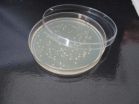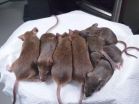(Press-News.org) According to his theory, bacteria that are non-resistant to antibiotics acquire said resistance accidentally because they take up the DNA of others that are resistant, due to the stress to which they are subjected.
A University of Granada researcher has formulated a new hypothesis concerning an enigma that the scientific community has still not been able to solve and which could revolutionise the pharmaceutical industry: Why are bacteria becoming increasingly more resistant to antibiotics? His work has revealed that the use of antibiotics can even cause non-resistant bacteria to become resistant because they take up the DNA of others that are already resistant.
Mohammed Bakkali, a scientist in the Genetics Department at the Faculty of Science of the UGR, maintains that our abuse of antibiotics "forces" the bacteria to take up the DNA of other bacteria that are resistant to said antibiotics, since the presence of antibiotics exposes them to a great stress. According to the researcher, "In this way, the non-resistant bacteria become resistant completely by accident on ingesting this DNA and can even become much more virulent, partly due to the stress we subject them to when we make an abusive use of antibiotics".
For decades, scientists from all over the world have been researching into when, how and why bacteria take up DNA from other antibiotic-resistant bacteria, thus becoming also resistant. The answers as to when there is DNA uptake (in unfavourable or stressful circumstances) and as to how the bacteria take it up are clear, but, up until now, "nobody has pinpointed the reason why bacteria ingest this genetic material",as Bakkali points out in an article published in the latest edition of the journal "Archives of Microbiology".
Under normal conditions,a bacterium could have a lot to lose if it 'decides' to take up DNA, since it does not have a 'DNA reader' enabling it to take up only those molecules that are of use to it and the most likely isthat this DNA will be dangerous, or even lethal.
They do not want that DNA, because they break it up
In his article, Mohammed Bakkali argues that, in reality, bacteria do not look for DNA to takeup (they appear not to 'want' this DNA, since they are constantly degrading it; in other words, breaking it up) and that this uptake is a chance event and the sub-product of a type of bacterial motility that is part of its response to the stress that the bacteria may be subjected to.
Therefore,our current indiscriminate use of antibiotics "not only selects the resistant bacteria, but also means that the bacteria take up more DNA, due to their increased motility in response to the stress that the antibiotic subjects them to". The result is that the stress caused by the antibiotic itself induces the uptake of genetic material that can bring about resistance to the antibiotic bybacteria that, otherwise, would not have taken up that DNA nor become resistant to the antibiotic. Furthermore, this effect is strengthened by its lack of specificity, since it occurs both in the target pathogen and in other bacteria.
The UGR researcher states that, when a bacterium takes up DNA from another antibiotic-resistantone (and which could have died due to another environmental factor), the bacterium that takes it up becomes resistant to that antibiotic. "Thus, the bacteria can go on adding to their arsenal of resistance to antibiotics and end up being resistant to a wide range of them, such as is the case of the multi-resistant strain of a staphylococcus, called Staphylococcus aurius, which creates havoc in many operating theatres.
INFORMATION:
Reference: Could DNA Uptake Be a Side Effect of Bacterial Adhesion and Twitching Motility?
M.Bakkali. Archives of Microbiology (Springer). DOI10.1007/s00203-013-0870-1
The article is available online via the following link: http://link.springer.com/article/10.1007/s00203-013-0870-1
New hypothesis: Why bacteria are becoming increasingly more resistant to antibiotics
2013-03-07
ELSE PRESS RELEASES FROM THIS DATE:
New gender benchmarking study: India is making slow progress in advancing women in S & T
2013-03-07
Delhi, March 7, 2013 - In the first gender benchmarking study of its kind, researchers have found that numbers of women in the science, technology and innovation fields are alarmingly low in the world's leading economies, and are actually on the decline in many, including the United States. India's low overall ranking in the study shows slow progress despite women friendly policies which have been in place for a number of years.
The full gender benchmarking study maps the opportunities and obstacles faced by women in science in Brazil, South Africa, India, the Republic ...
New gender benchmarking study: South Africa ranks low on women participating in STI
2013-03-07
Cape Town, March 7, 2013 – In the first gender benchmarking study of its kind, researchers have found that numbers of women in the science, technology and innovation fields (STI) are alarmingly low in the world's leading economies, and are actually on the decline in many, including the United States. For South Africa, results show that women have more opportunities available to them than ever before, however, their participation in the science, technology and innovation workforce remains low.
The full gender benchmarking study maps the opportunities and obstacles faced ...
Japanese researchers succeed in making generations of mouse clones
2013-03-07
Using the technique that created Dolly the sheep, researchers from the RIKEN Center for Developmental Biology in Kobe, Japan have identified a way to produce healthy mouse clones that live a normal lifespan and can be sequentially cloned indefinitely.
Their study is published today in the journal Cell Stem Cell.
In an experiment that started in 2005, the team led by Dr. Teruhiko Wakayama has used a technique called somatic cell nuclear transfer (SNCT) to produce 581 clones of one original 'donor' mouse, through 25 consecutive rounds of cloning.
SNCT is a widely ...
High BMI linked to heart attack, stroke in young women
2013-03-07
SAN FRANCISCO (March 7, 2013) —A nationwide study of women in Denmark who are of child-bearing age finds that those who are obese appear to have a much greater risk of heart attack or stroke, according to research being presented at the American College of Cardiology's 62nd Annual Scientific Session.
In fact, women with a high body mass index (BMI)—a measure of the body's fat content—that is indicative of obesity were twice as likely as those of normal weight to suffer a potentially life-threatening heart attack or stroke within just four to five years following childbirth. ...
Duckweed as a cost-competitive raw material for biofuel production
2013-03-07
The search for a less-expensive, sustainable source of biomass, or plant material, for producing gasoline, diesel and jet fuel has led scientists to duckweed, that fast-growing floating plant that turns ponds and lakes green. That's the topic of a report in ACS' journal Industrial & Engineering Chemistry Research.
Christodoulos A. Floudas, Xin Xiao and colleagues explain that duckweed, an aquatic plant that floats on or near the surface of still or slow-moving freshwater, is ideal as a raw material for biofuel production. It grows fast, thrives in wastewater that has ...
First discovery of a natural topological insulator
2013-03-07
In a step toward understanding and exploiting an exotic form of matter that has been sparking excitement for potential applications in a new genre of supercomputers, scientists are reporting the first identification of a naturally occurring "topological insulator" (TI). Their report on discovery of the material, retrieved from an abandoned gold mine in the Czech Republic, appears in the ACS journal Nano Letters.
Pascal Gehring and colleagues point out that synthetic TIs, discovered only a decade ago, are regarded as a new horizon in materials science. Unlike conventional ...
Report offers an in-depth examination of health centers' role in family planning
2013-03-07
WASHINGTON and NEW YORK—A report released today by the George Washington University School of Public Health and Health Services (SPHHS) and the RCHN Community Health Foundation offers the first-ever in-depth examination of health centers' role in access to family planning. The report finds that virtually all health centers furnish family planning services to some extent but for both financial and non-financial reasons, only 1 in 5 is able to offer access to the full range of contraceptive services.
The report offers a series of recommendations to strengthen performance, ...
Test-taking may improve learning in people of all ages
2013-03-07
WASHINGTON – Older adults who haven't been in school for a while are as capable of learning from tests as younger adults and college students, according to new research published by the American Psychological Association.
No matter their age or if they work or go to college full time, people appear to learn more when tested on material, rather than simply rereading or restudying information, according to research published online in the APA journal Psychology and Aging.
"The use of testing as a way to learn new information has been thoroughly examined in young students. ...
New gender benchmarking study: Brazil succeeding in providing a positive STI environment for women
2013-03-07
São Paolo, March 7, 2013 – In the first gender benchmarking study of its kind, researchers have found that numbers of women in the science, technology and innovation fields are alarmingly low in the world's leading economies, and are actually on the decline in many, including the United States. Results from Brazil show that despite women having a strong representation in parts of the science, technology and innovation sector, and a slight increase in engineering, physics and computer science, overall numbers are on the decline.
Brazil ranks the highest in this study ...
Lizards facing mass extinction
2013-03-07
Climate change could lead to dozens of species of lizards becoming extinct within the next 50 years, according to new research published today.
Globally it has been observed that lizards with viviparous reproduction (retention of embryos within the mother's body) are being threatened by changing weather patterns. A new study suggests that the evolution of this mode of reproduction, which is thought to be a key successful adaptation, could, in fact, be the species' downfall under global warming.
Researchers from the University of Exeter and the University of Lincoln ...

